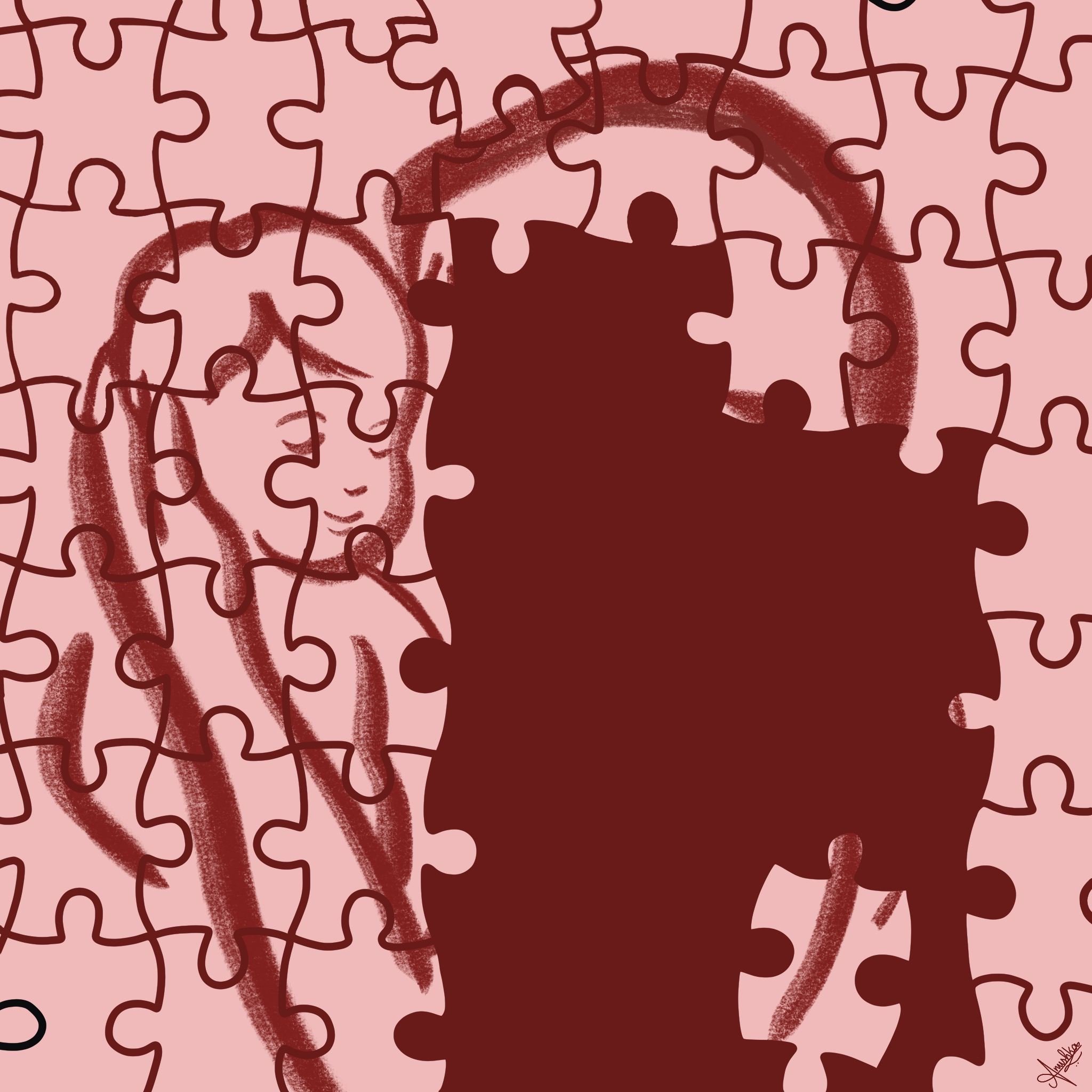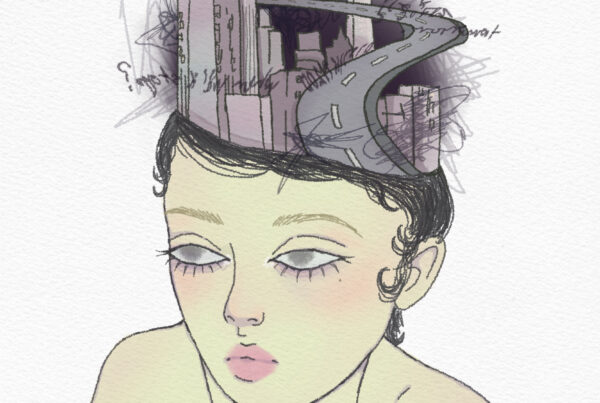
“Women’s bodies can be many things. They can be mirrors, weights, rewards; but so often they are seen from outside. Experiences that are unique to them remain anomalous, smoothly impenetrable, like bubbles of water to which significance refuses to adhere. What could we possibly learn about being human from that which only happens to half of us?” – Jessie Greengrass for the Guardian (2019)
“Women’s bodies can be many things. They can be mirrors, weights, rewards; but so often they are seen from outside. Experiences that are unique to them remain anomalous, smoothly impenetrable, like bubbles of water to which significance refuses to adhere. What could we possibly learn about being human from that which only happens to half of us?” – Jessie Greengrass for the Guardian (2019)

Illustration by Anushka Sabhanam

Illustration by Anushka Sabhanam
It may seem hardly surprising to some, while entirely unexpected to others, that research in the realm of pregnancy has wholeheartedly focused on the life-to-be, the result of creation, rather than the laborious and unique cultivation of that life. We humans have a knack for looking for answers, using our bare hands to dig to the heart of the universe in hope of finding solutions, even when they may be in front of us. How can you talk about the creation without mentioning the creator?
The research realm of fetal development is alive and well, but perhaps not in the way you might imagine. From explorations of gestational period progression, to analysis of the effect of the mother’s environment on the fetus, to nutritional effects on pregnancy, the field is abundant in the angles it takes on fetal health. Research assessing the effects of pregnancy on the body, brain and mind of the pregnant woman, however, has only seen a recent surge in interest. One prominent researcher in the area is Elseline Hoekzema, a researcher in Amsterdam interested in neuroplasticity and brain changes during the perinatal period (Elseline Hoekzema, n.d.). To define, the perinatal period is the time from when you become pregnant to when you give birth. The postpartum period is the time directly after delivery of the child, with the cutoff point being less defined.
One of Hoekzema’s noteworthy papers assessed the differences in gray matter (GM) volume pre and post pregnancy, using first-time fathers as a control group to rule out unique changes in the brain from anticipated parenthood (Hoekzema et al., 2016). While GM volume reduction is associated with aging, it can also indicate neuroplasticity, the brain’s ability to respond and adapt to life experience on a neural level (Voss et al., 2017). The results indicated prominent, long-lasting, selective changes in GM volume when comparing the brain pre and post pregnancy. The effects differed from those of controls, and were able to retrospectively predict which brain scans belonged to women that underwent pregnancy and which did not.
Behaviorally, the paper discussed these GM volume changes as having substantial overlap with areas subserving social cognition. The preliminary task conducted to test this hypothesis showed that the affected areas had a much stronger fMRI activation when women were responding to visual cues of their own babies at postpartum, compared to other babies. Wide-ranging systems for motivation, executive functioning and somatosensory information were also implicated in this initial finding —mediated by experience-dependent plasticity during the postpartum period. This is just one paper that indicates the importance of discussing pregnancy and its effects on the woman’s brain, shedding light on both the nature of mother-child interactions, but also clarity in understanding what exactly a woman goes through in this period and why.
“How can you talk about the creation without mentioning the creator?
”
Adjacent to research about general well-being and progression of brain changes in pregnancy, another stream focuses on emotional and mental complications during the perinatal and the postpartum period, referred to as Postpartum (or Perinatal) Mood and Anxiety Disorders (PMADs). PMADs constitute a wide range of symptoms and comorbid disorders, such as depression, anxiety, PTSD, and OCD, all within the context of pregnancy (Shklarski & Kalogridis, 2022). One paper made the distinction that about 1 in 5 women experienced PMADs (Fairbrother et al., 2015). A particularly researched disorder in this area is Postpartum Depression (PPD), which is generally recognized as major depressive disorder (MDD) with an onset within one month of delivery (Pearlstein et al.,2014). The research group noted that diagnosis criteria overlap with MDD, with possible additions of sleep/appetite disturbances, feelings of guilt and worthlessness, and much more. Moreover, the paper notes that ‘postpartum blues’, feeling down and general mood swings, are common and do not require intervention in postpartum women, but could progress into PPD. Varying biological and psychological theories are proposed as factors in the development of PPD, such as stress, level of social support, hormonal fluctuation and hormone-induced changes in sleep patterns.
Yet another facet of the pregnant brain and its realities is expressed through the lens of cultural experience. Experiences of pregnancy can be very robustly defined by socio-cultural attitudes and expectations, as well as the level of understanding of this time. A recent surge of research specifically assessed postpartum effects in marginalized, socioeconomically low, and/or non-Western cultures, where the awareness of PPD is much lower. A quote from one qualitative analysis of PPD experiences reveals, “We might not accept that we have depression and say, ‘No, I’m fine.’ It is different from other diseases. Depression is very silent. This cannot be easily accepted”(Maxwell et al., 2018). Feelings of hopelessness, fear of stigmatization, and pressures and idealization are the core themes for cultural effects of having PPD in a community with no understanding of it. One woman notes that “There’s so much going on [in my country of origin, after a woman has a child] usually, that you don’t have time to be depressed or sad! And you get pampered quite a lot—for 45 days you don’t leave the house, and a woman comes and gives you a massage every day, and your relatives come to help you with the baby, so really you get quite pampered. You don’t realize it until you come here and miss it… ”. This can further illustrate the effect of differing cultural approaches and their effects on both the mother and child’s health during this crucial period. While some cultures emphasize collective action and careful attention, others may highlight more clinical approaches, hitting below the mark on the social support factor.
“Yet another facet of the pregnant brain and its realities is expressed through the lens of cultural experience.”
Can there be a value in the integration of subjective experience and scientific research in the realm of PPD? For example, Shklarski and Kalogridis (2022) strayed away from the medical intervention approach to PMADs disorders, and assessed the function and value of doulas in assisting women throughout the turbulent period of pregnancy and postpartum. Doulas are women (and more recently, men) who assist pregnant women with their emotional needs throughout the perinatal and postpartum period, through a variety of educational and practical services. The paper emphasizes both the role of emotional support, as well as the unique position of a person intimately assisting a woman in their pregnancy. Of most relevance is the potential for these persons to look out for psychological inconsistencies and early signs of PMADs. Could this bring us a step closer to cracking the intricacies of pregnancy? Does it all just come down to emotional and social support? Unfortunately, this is yet again just another angle that needs further investigation and much more research.
It is also important to note the paramount effect of partner support within the grand scheme of social support as a protective factor. A vast body of knowledge indicates partner support as a primary protective factor from mental disorder onset during the perinatal period (Antoniou et al., 2022). Moreover, Suto et al. (2017) reviewed the effects of prenatal childbirth education on partners of pregnant women on paternal postnatal mental health and couple relationship. Despite the review spanning research on various educational interventions and even more diverse measured effects, the general conclusion seems to be that parental education can benefit couple relationships, reduce both paternal and maternal stress and anxiety, and manage expectations.
Does this all mean to say that a woman’s experience during pregnancy is a black box, full of unknowns, uncertainty, and negativity? Certainly not! It is more so that, in the abundance of ongoing (and very essential!) fetal research, addressing what is happening strictly in the pregnant woman’s body and mind has not received the same nuance in the scientific field. Layer on top of this a community that does not understand how to address and accommodate such fundamental changes in a woman’s psychological and physical state, and it can feel like a turbulent, somewhat isolated experience. In order to address both general well-being and PMADs in pregnancy in the social discourse, more attention should be drawn to these themes in scientific literature. Consequently, the growth of scientific research will naturally transition into daily discourse, lifting certain social expectations of keeping pregnancy a private, strictly ‘magical’ time. The true magic is in grounding this time in reality, aided by feelings of support and understanding, both intrinsically and from one’s surroundings. <<
References
– Antoniou, E., Tzanoulinou, M., Stamoulou, P., & Orovou, E. (2022). The important role of partner support in Women’s Mental Disorders during the perinatal Period. A literature review. PubMed, 17(1), 194–200. https://doi.org/10.26574/maedica.2022.17.1.194
– Elseline Hoekzema. (n.d.). Amsterdam UMC Research Portal. https://researchinformation.amsterdamumc.org/en/persons/elseline-hoekzema,
– Fairbrother, N., Young, A., Antony, M., & Tucker, E. (2015). Depression and anxiety during the perinatal period. BMC Psychiatry, 15, 206–215. 10.1186/s12888-015-0526-6
– Greengrass, J. G. (2019, August 21). Why does literature ignore pregnancy? The Guardian. https://www.theguardian.com/books/booksblog/2018/feb/22/why-does-literature-ignore-pregnancy,
– Hoekzema, E., Barba-Müller, E., Pozzobon, C., Picado, M., Lucco, F., García‐García, D., Soliva, J. C., Tobeña, A., Desco, M., Crone, E. A., Ballesteros, A., Carmona, S., & Vilarroya, Ó. (2016). Pregnancy leads to long-lasting changes in human brain structure. Nature Neuroscience, 20(2), 287–296. https://doi.org/10.1038/nn.4458,
– Maxwell, D., Robinson, S., & Rogers, K. (2018). “I keep it to myself”: A qualitative meta‐interpretive synthesis of experiences of postpartum depression among marginalised women. Health & Social Care in the Community, 27(3), e23–e36. https://doi.org/10.1111/hsc.12645,
– Shklarski, L., & Kalogridis, L. (2022). Promotion and Prevention of Perinatal mood and Anxiety Disorders: Doulas’ Roles and Challenges. Journal of Perinatal Education, 31(2), 82–93. https://doi.org/10.1891/jpe-2021-00058,
– Suto, M., Takehara, K., Yamane, Y., & Ota, E. (2017). Effects of prenatal childbirth education for partners of pregnant women on paternal postnatal mental health and couple relationship: A systematic review. Journal of Affective Disorders, 210, 115–121. https://doi.org/10.1016/j.jad.2016.12.025
– Pearlstein, T., Howard, M., Salisbury, A. L., & Zlotnick, C. (2009). Postpartum depression. American Journal of Obstetrics and Gynecology, 200(4), 357–364. https://doi.org/10.1016/j.ajog.2008.11.033.
– Voss, P., Thomas, M. E., Cisneros-Franco, J. M., & De Villers-Sidani, É. (2017). Dynamic Brains and the Changing Rules of Neuroplasticity: Implications for learning and recovery. Frontiers in Psychology, 8. https://doi.org/10.3389/fpsyg.2017.01657
It may seem hardly surprising to some, while entirely unexpected to others, that research in the realm of pregnancy has wholeheartedly focused on the life-to-be, the result of creation, rather than the laborious and unique cultivation of that life. We humans have a knack for looking for answers, using our bare hands to dig to the heart of the universe in hope of finding solutions, even when they may be in front of us. How can you talk about the creation without mentioning the creator?
The research realm of fetal development is alive and well, but perhaps not in the way you might imagine. From explorations of gestational period progression, to analysis of the effect of the mother’s environment on the fetus, to nutritional effects on pregnancy, the field is abundant in the angles it takes on fetal health. Research assessing the effects of pregnancy on the body, brain and mind of the pregnant woman, however, has only seen a recent surge in interest. One prominent researcher in the area is Elseline Hoekzema, a researcher in Amsterdam interested in neuroplasticity and brain changes during the perinatal period (Elseline Hoekzema, n.d.). To define, the perinatal period is the time from when you become pregnant to when you give birth. The postpartum period is the time directly after delivery of the child, with the cutoff point being less defined.
One of Hoekzema’s noteworthy papers assessed the differences in gray matter (GM) volume pre and post pregnancy, using first-time fathers as a control group to rule out unique changes in the brain from anticipated parenthood (Hoekzema et al., 2016). While GM volume reduction is associated with aging, it can also indicate neuroplasticity, the brain’s ability to respond and adapt to life experience on a neural level (Voss et al., 2017). The results indicated prominent, long-lasting, selective changes in GM volume when comparing the brain pre and post pregnancy. The effects differed from those of controls, and were able to retrospectively predict which brain scans belonged to women that underwent pregnancy and which did not.
Behaviorally, the paper discussed these GM volume changes as having substantial overlap with areas subserving social cognition. The preliminary task conducted to test this hypothesis showed that the affected areas had a much stronger fMRI activation when women were responding to visual cues of their own babies at postpartum, compared to other babies. Wide-ranging systems for motivation, executive functioning and somatosensory information were also implicated in this initial finding —mediated by experience-dependent plasticity during the postpartum period. This is just one paper that indicates the importance of discussing pregnancy and its effects on the woman’s brain, shedding light on both the nature of mother-child interactions, but also clarity in understanding what exactly a woman goes through in this period and why.
“How can you talk about the creation without mentioning the creator?
”
Adjacent to research about general well-being and progression of brain changes in pregnancy, another stream focuses on emotional and mental complications during the perinatal and the postpartum period, referred to as Postpartum (or Perinatal) Mood and Anxiety Disorders (PMADs). PMADs constitute a wide range of symptoms and comorbid disorders, such as depression, anxiety, PTSD, and OCD, all within the context of pregnancy (Shklarski & Kalogridis, 2022). One paper made the distinction that about 1 in 5 women experienced PMADs (Fairbrother et al., 2015). A particularly researched disorder in this area is Postpartum Depression (PPD), which is generally recognized as major depressive disorder (MDD) with an onset within one month of delivery (Pearlstein et al.,2014). The research group noted that diagnosis criteria overlap with MDD, with possible additions of sleep/appetite disturbances, feelings of guilt and worthlessness, and much more. Moreover, the paper notes that ‘postpartum blues’, feeling down and general mood swings, are common and do not require intervention in postpartum women, but could progress into PPD. Varying biological and psychological theories are proposed as factors in the development of PPD, such as stress, level of social support, hormonal fluctuation and hormone-induced changes in sleep patterns.
Yet another facet of the pregnant brain and its realities is expressed through the lens of cultural experience. Experiences of pregnancy can be very robustly defined by socio-cultural attitudes and expectations, as well as the level of understanding of this time. A recent surge of research specifically assessed postpartum effects in marginalized, socioeconomically low, and/or non-Western cultures, where the awareness of PPD is much lower. A quote from one qualitative analysis of PPD experiences reveals, “We might not accept that we have depression and say, ‘No, I’m fine.’ It is different from other diseases. Depression is very silent. This cannot be easily accepted”(Maxwell et al., 2018). Feelings of hopelessness, fear of stigmatization, and pressures and idealization are the core themes for cultural effects of having PPD in a community with no understanding of it. One woman notes that “There’s so much going on [in my country of origin, after a woman has a child] usually, that you don’t have time to be depressed or sad! And you get pampered quite a lot—for 45 days you don’t leave the house, and a woman comes and gives you a massage every day, and your relatives come to help you with the baby, so really you get quite pampered. You don’t realize it until you come here and miss it… ”. This can further illustrate the effect of differing cultural approaches and their effects on both the mother and child’s health during this crucial period. While some cultures emphasize collective action and careful attention, others may highlight more clinical approaches, hitting below the mark on the social support factor.
“Yet another facet of the pregnant brain and its realities is expressed through the lens of cultural experience.”
Can there be a value in the integration of subjective experience and scientific research in the realm of PPD? For example, Shklarski and Kalogridis (2022) strayed away from the medical intervention approach to PMADs disorders, and assessed the function and value of doulas in assisting women throughout the turbulent period of pregnancy and postpartum. Doulas are women (and more recently, men) who assist pregnant women with their emotional needs throughout the perinatal and postpartum period, through a variety of educational and practical services. The paper emphasizes both the role of emotional support, as well as the unique position of a person intimately assisting a woman in their pregnancy. Of most relevance is the potential for these persons to look out for psychological inconsistencies and early signs of PMADs. Could this bring us a step closer to cracking the intricacies of pregnancy? Does it all just come down to emotional and social support? Unfortunately, this is yet again just another angle that needs further investigation and much more research.
It is also important to note the paramount effect of partner support within the grand scheme of social support as a protective factor. A vast body of knowledge indicates partner support as a primary protective factor from mental disorder onset during the perinatal period (Antoniou et al., 2022). Moreover, Suto et al. (2017) reviewed the effects of prenatal childbirth education on partners of pregnant women on paternal postnatal mental health and couple relationship. Despite the review spanning research on various educational interventions and even more diverse measured effects, the general conclusion seems to be that parental education can benefit couple relationships, reduce both paternal and maternal stress and anxiety, and manage expectations.
Does this all mean to say that a woman’s experience during pregnancy is a black box, full of unknowns, uncertainty, and negativity? Certainly not! It is more so that, in the abundance of ongoing (and very essential!) fetal research, addressing what is happening strictly in the pregnant woman’s body and mind has not received the same nuance in the scientific field. Layer on top of this a community that does not understand how to address and accommodate such fundamental changes in a woman’s psychological and physical state, and it can feel like a turbulent, somewhat isolated experience. In order to address both general well-being and PMADs in pregnancy in the social discourse, more attention should be drawn to these themes in scientific literature. Consequently, the growth of scientific research will naturally transition into daily discourse, lifting certain social expectations of keeping pregnancy a private, strictly ‘magical’ time. The true magic is in grounding this time in reality, aided by feelings of support and understanding, both intrinsically and from one’s surroundings. <<



